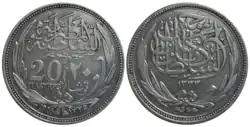Hussein Kamel of Egypt
Sultan Hussein Kamel (Arabic: السلطان حسين كامل; 21 November 1853 – 9 October 1917) was the Sultan of Egypt from 19 December 1914 to 9 October 1917, during the British protectorate over Egypt. He was the first person to hold the title of Sultan of Egypt since the killing of Sultan Tuman II by the Ottomans in 1517 following their conquest of Egypt.
| Hussein Kamel | |
|---|---|
_(pd).jpg.webp) Portrait by Charles Chusseau-Flaviens | |
| Sultan of Egypt and the Sudan | |
| Reign | 19 December 1914 – 9 October 1917 |
| Predecessor | Abbas Helmy II (as Khedive of Egypt) |
| Successor | Fuad I |
| Prime Minister | Hussein Roshdy Pasha |
| Born | 21 November 1853 Cairo, Egypt Eyalet, Ottoman Empire |
| Died | 9 October 1917 (aged 63) Cairo, Sultanate of Egypt |
| Burial | |
| Spouse | |
| Issue | Prince Kamal el Dine Hussein Princess Kazima Hussein Princess Kamila Hussein Prince Ahmed Kazim Hussein Princess Kadria Hussein Princess Samiha Hussein Princess Badia Hussein |
| House | Alawiyya |
| Father | Isma'il I |
| Mother | Nur Felek Qadin |
Life
Hussein Kamel was the second son of Khedive Ismail Pasha, who ruled Egypt from 1863 to 1879. He was declared Sultan of Egypt on 19 December 1914, after the occupying British forces had deposed his nephew, Khedive Abbas Hilmi II, on 5 November 1914. Though presented as the re-establishment of the pre-Ottoman Egyptian sultanate, the newly created Sultanate of Egypt was to be a British protectorate, with effective political and military power vested in British officials. This brought to an end the de jure Ottoman sovereignty over Egypt, which had been largely nominal since Muhammad Ali's seizure of power in 1805.

Upon Hussein Kamel's death, his only son, Prince Kamal el Dine Hussein, declined the succession, and Hussein Kamel's brother Ahmed Fuad ascended the throne as Fuad I. At the beginning of Naguib Mahfouz's novel Palace Walk, Ahmad Abd al-Jawwad says "What a fine man Prince Kamal al-Din Husayn is! Do you know what he did? He refused to ascend the throne of his late father so long as the British are in charge."[1]
Stereoscope photographs of the coronation procession and burial procession of Sultan Hussein are available on the Rare Books and Special Collections Digital Library of the American University in Cairo.
Honours

- Domestic
- Founder and Sovereign of the Order of Muhammad Ali
- Founder and Sovereign of the Order of Ismail
- Founder and Sovereign of the Order of the Nile
- Founder and Sovereign of the Order of the Virtues
- Foreign
- Ottoman Empire: Order of Osmanieh, 1st Class
- Ottoman Empire: Order of the Medjidie, 1st Class
- Austria-Hungary: Grand Cross of the Order of Franz Joseph, 1869[2]
- Sweden: Commander Grand Cross of the Order of the Sword, 1891[3]
- United Kingdom of Great Britain and Ireland: Honorary Grand Cross of the Order of the Bath (civil division), 19 December 1914[4]
- French Third Republic: Grand Cross of the Legion d'Honneur, 1916
- Kingdom of Italy: Grand Cross of the Order of Saints Maurice and Lazarus, 1916
- Greece: Grand Cross of the Order of the Redeemer, 1916
- Kingdom of Romania: Grand Cross of the Order of the Crown, 1916
- Belgium: Grand Cross of the Order of Leopold II, 1917
References
- Naguib Mahfouz, Palace Walk (Anchor Books, 1991), p. 12
- "Ritter-Orden: Kaiserlich-österreichischer Franz Joseph-orden", Hof- und Staatshandbuch der Österreichisch-Ungarischen Monarchie, 1913, p. 174, retrieved 9 February 2021
- "Kungl. Svenska Riddareordnarna", Sveriges statskalender (in Swedish), 1915, p. 674, retrieved 10 February 2021 – via runeberg.org
- "No. 29021". The London Gazette. 29 December 1914. p. 11132.
External links
 Media related to Hussein Kamel of Egypt at Wikimedia Commons
Media related to Hussein Kamel of Egypt at Wikimedia Commons- Stereoscopes of Hussein Kamel's coronation and burial processions
.svg.png.webp)